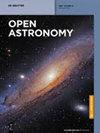基于改进Levenberg-Marquardt算法的神经网络大气模型
IF 0.5
4区 物理与天体物理
Q4 ASTRONOMY & ASTROPHYSICS
引用次数: 2
摘要
摘要传统的大气模型是基于对影响空间大气密度的各种因素的分析和拟合。神经网络模型并没有专门分析大气模型中每个影响因素的多项式,而是使用大数据集进行网络构建。分析了两种传统的大气模型算法,识别了影响大气模型的主要因素,提出了一种基于包含各种影响因素的神经网络的大气模型。根据仿真误差,采用Levenberg-Marquardt算法迭代实现网络权值的快速校正,得到了最优的神经网络大气模型。空间大气采用基于神经网络的大气模型进行模拟计算,其平均误差率低于DTM2013模型和MSIS00模型等传统大气模型。同时,与传统大气模型相比,基于神经网络的大气模型的计算复杂度显著简化。本文章由计算机程序翻译,如有差异,请以英文原文为准。
The atmospheric model of neural networks based on the improved Levenberg-Marquardt algorithm
Abstract Traditional atmospheric models are based on the analysis and fitting of various factors influencing the space atmosphere density. Neural network models do not specifically analyze the polynomials of each influencing factor in the atmospheric model, but use large data sets for network construction. Two traditional atmospheric model algorithms are analyzed, the main factors affecting the atmospheric model are identified, and an atmospheric model based on neural networks containing various influencing factors is proposed. According to the simulation error, the Levenberg-Marquardt algorithm is used to iteratively realize the rapid network weight correction, and the optimal neural network atmospheric model is obtained. The space atmosphere is simulated and calculated with an atmospheric model based on neural networks, and its average error rate is lower than that of traditional atmospheric models such as the DTM2013 model and the MSIS00 model. At the same time, the calculation complexity of the atmospheric model based on the neural networks is significantly simplified than that of the traditional atmospheric model.
求助全文
通过发布文献求助,成功后即可免费获取论文全文。
去求助
来源期刊

Open Astronomy
Physics and Astronomy-Astronomy and Astrophysics
CiteScore
1.30
自引率
14.30%
发文量
37
审稿时长
16 weeks
期刊介绍:
The journal disseminates research in both observational and theoretical astronomy, astrophysics, solar physics, cosmology, galactic and extragalactic astronomy, high energy particles physics, planetary science, space science and astronomy-related astrobiology, presenting as well the surveys dedicated to astronomical history and education.
 求助内容:
求助内容: 应助结果提醒方式:
应助结果提醒方式:


